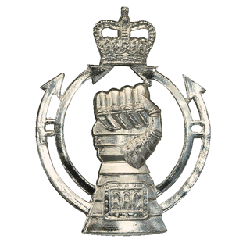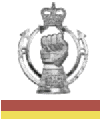|
British Army: 2300AD Yeomanry
The Yeomanry is the TAVR part of the Royal Armoured Corps. It provides most of the striking power for the UK Defence Forces as well as supplementing the deployment forces with addition operational reconnaissance assets. Yeomanry units are equipped with hovertanks, ground tanks, reconnaissance vehicles and now combat walkers. The Yeomanry has been the most effected in the recent reforms as many of its units have had to re-role from light recce to other tasks, most are still not yet fully effective in their new roles. The Yeomanry has traditionally been the mounted arm of the volunteers and militia who protected the British Isles when the regular army was overseas. The landed gentry and the rural middle classes usually made up the bulk of these units, who also had a substantial social role. The Yeomanry has long has a reputation as being the reserve of reactionaries and social conservatives, much like the Cavalry. The Yeomanry provided some fighting units during the early years of World War III, but most units remained committed to home defence. Those that survived the devastation were used to try and preserve those islands of civilisation that remained from both waves of desperate refugees and marauders. Ironically many of the more organised marauders would become a part of the Yeomanry after being co-opted as military auxiliaries during the long Pacification campaign. The Yeomanry has languished for much of the last three centuries before the recent revival starting with the re-equipment of several units with obsolete Cromwell hovertanks in the 2270's. This brought the Yeomanry back into the business of manoeuvre warfare and greatly increased its profile and recruiting levels. Today the culture of the Yeomanry is divided between the socially prestigious 'Old Yeomanry' units and those formations descended from marauder bands. The older units are dominated by the rural upper middle classes whilst the other units recruit more from the working classes and urban areas and are much less obsessed with maintaining 'cavalryesque' social standards. Unlike the infantry there are no formal linkages between the Yeomanry and regular RAC formations. However informal links are maintained, especially as a result of cross training.
Regimental History Many Yeomanry regiments date back to the Twilight Era, however they usually have substantially different origins. These four regiments are examples. The Border Reivers Yeomanry The BRY is a formation that traces its history back to the Twilight Era. In the aftermath of the nuclear attacks on Britain, the Anglo-Scottish borders region was relatively untouched but the small communities there were prey to attacks from marauders and military forces. In response the 'Border Reivers' (taking the name from the historic raiders of the area) came into being as a guerrilla force, fighting with and sometimes being allied to the various factions that passed through the area. The Reivers later allied with the British Army as it came into the borders during the Pacification, and were used as advisors and scouts. They later were formalised as a Yeomanry regiment, and to this day maintain their traditions from the time of their foundation. They still recruit from both sides of the border and now are re-training with Bowman combat walkers. The Loyal Manchester Yeomanry (Red Devils) The LMY began as a marauder group based around a number of Mancunian football supporters, many of who had military experience. After the nuclear strikes they quickly became one of the centres of power in the devastated North West of England. The original group was reinforced by defecting TA soldiers and others seeking to survive the breakdown of society. The group dominated its home areas by force and brutality and launched military expeditions to other areas seeking to seize resources. They clashed frequently with other, less organised marauders and territorial forces. However the return of the British Army from the continent left them completely outclassed as the battle-hardened regulars tore them to pieces. In the end the group had no option but to surrender after its commander saw the writing on the wall after heavy defeats in Cumbria. Most of the group was disbanded but the kernel became auxiliaries to the British Army from when they eventually became a Yeomanry formation. The unit still recruits predominantly from the Greater Manchester area, and is currently a recce formation. The Royal Welsh Yeomanry The two RWY regiments date from the Twilight War, originally being part of the Welsh Voluntary National Army. The WVNA patrolled the borders of the North Wales enclave of the self-declared Republic of Wales, keeping out refugees and protecting the area. In 2004 after long negotiation the Republic of Wales dissolved itself, becoming once again part of the UK except with enhanced devolution. The WVNA was for a time part of the British Army proper, but was dissolved in 2010, partly because of its reputation for brutality against non-Welsh refugees. Instead the WNVA became part of the Territorial Army, splitting into two new formations the RWY and North Wales Rifle Volunteers. Today these units are just normal parts of the TA, however they still recruit mainly from North Wales and conduct most of their business in Welsh. Although 2 RWY has many recruits from just over the border. The Yorkshire Light Horse (North Riding) The YLH was formed during the Twilight War at the end of the 20th Century. Whilst the south and midlands of England had been devastated, there were parts of the north that were untouched. The military using all available troops (including recruits from the School of Infantry) created a cordon and buffer zone in North Yorkshire to ensure the industrial areas further north were not flooded by refugees and thrown into further chaos. To help them do this an number of irregular units were set up, amongst these was the YLH. As North Yorkshire was a rural area with a long history of raising horses the YLH was started up to make use of this resource. Acting as mounted infantry the YLH patrolled from the Dales to the Moors across the Vale of York, the unit kept the refugees under control as well as helping to hunt down marauders from further south. After the war the unit remained as a part time recce formation, equipped with Land Rovers. However since the Defence Review of 2260 the unit has taken a much more proactive role. Currently it is equipped with newly acquired Cavalier Hovertanks handed down as the regular army re-equipped with the more modern Montgomery replacing the aged Cromwell Hovertanks they had been using. The YLH is the armoured regiment for 23 Mech Bde and recruits from across Yorkshire and trains using the facilities at Catterick Garrison. Yeomanry Regiment Roles The Yeomanry regiments of the British Army have four main roles, but generally share a similar internal organisation. A regiment consists of four 'sabre' squadrons lettered from A to D (although this is a rule of thumb), and an HQ Squadron. Heavy Tank Regiments There is only one HT Yeomanry unit, 1 CLY. The unit is equipped with 50 heavy Churchill tanks. Each squadron having 12 vehicles in addition to REME and logistics formations. The HQ Squadron has administrative, recce and drone troops. 1 CLY has the distinction of being the most expensive formation in the TAVR. (1 CLY) Medium Tank Regiments MT units are equipped with hover tanks and form the back bone of British armoured formations. Armed with impressive firepower and blessed with excellent mobility MT units can take on most tasks, and when combined with infantry in battle groups they can take on almost any opponents. MT units will normally avoid combat with opposing tank units and attempt to penetrate though gaps in his lines and caused havoc in his rear areas. Yeomanry MT units form the main elements of the Mechanised Brigades, and are each equipped with 50 Cavalier HBT. (R WX Y, DLY, R SCOTS Y, YLH, 2 CLY, 1 RWY, 2 RWY, R ANGLIAN Y, STAFFS Y, QO OX H) Armoured Reconnaissance Regiments Recce units are equipped with light ACV fighting vehicles equipped with drones and extensive sensor arrays. Recce units are normally employed at Divisional level to provide tactical information for the division to plan its operations. Recce squadrons have 12 vehicles, but unlike their regular counterparts have no integral Medium Tank troop. When in operation a recce unit may be spread over hundreds of miles with each of its squadrons operating independently of one another and far in front of friendly troops. Troopers may also spend much of their time on foot manning observation posts (OP's). Although the recce regiment's raison d'Ítre is to provide information, they may also carry out raids on lightly protected logistics and rear area troops. (RY, QOY, RMY, LMY) Combat Walker Regiments A new role for the Yeomanry there are 3 CW regiments attached to 18 Mech Bde. These have followed a successful experiment with the all CW equipped 12 RGJ. Each regiment will consist of four squadrons each composed of two CW Troops, which will give a regimental strength of some 200 Bowman CW. These regiments will not operate en-masse but rather will be dispersed to the Mechanised or Infantry Divisions when required. (BRY, KOLY, NY) Copyright 2009, D Hebditch
|


